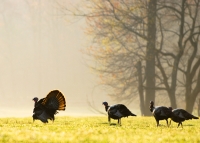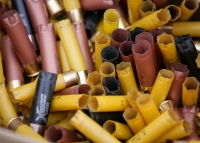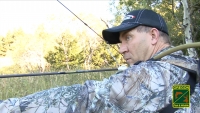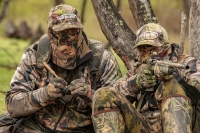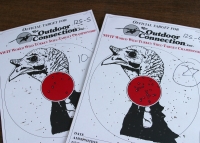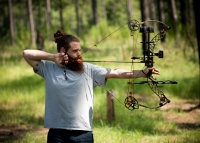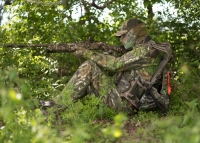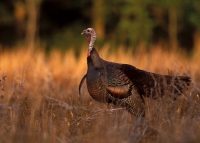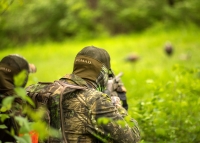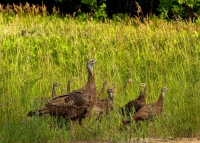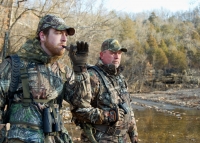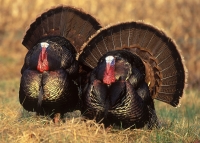
After the shot, field dressing and cooking
After the shot
After the shot, don’t take your eyes off the turkey. Quickly and safely get to the downed bird to make sure it’s dead, or to take a second shot if it’s not.
Turkeys are high-strung birds that can move quickly. A lot can happen between when you take a shot and when your bullet or arrow hits the bird that can lead to a wounded bird. You’ll want to be ready to take a second before the bird can run or fly away.
Follow up for shotgun hunters
When turkey hunting with a shotgun, keep the gun in a ready position, pointed at the bird, even if the turkey is down. When a turkey is first hit, it may fall to the ground in shock. However, if it's only been wounded, the bird’s likely to come to and try to run or fly off. When this happens, you’ll want to deliver another shot as soon as possible.
When approaching a downed turkey, don’t mistake a flopping, head-shot turkey for one that’s trying to get away. Firing a second, but unnecessary shot, will just put more shotgun pellets into the meat of the bird.
Follow up for bowhunters
When turkey hunting with a bow, have an arrow nocked and ready for a follow-up shot. If hunting from a ground blind, the terrain may determine if you need to get out of the blind to take a second shot, or if you can take another shot from within the blind.
If you’re in flat, short-grass terrain, you may be able to see the turkey moving away and get a second shot off from within the blind. In taller grass or rolling terrain, it may be quicker and more efficient to get out of the blind (quickly) in order to track the bird for a second shot.
Tracking a wounded bird
A turkey taken with a shotgun usually drops on the spot -- a head shot is quickly lethal. However, even a well-placed shot with an arrow may only wound a bird that can run or fly away after being hit.
In these cases, you may need to follow the bird to recover it or take a second shot. Start by keep you eye on the bird until it’s out of sight, so you’ll know where to start looking.
Turkeys don’t leave much blood when they’ve been hit so look for tracks, loose feathers, or bent grass and brush. If there’s dew on the grass during a morning hunt, it can be a good clue to the turkey’s location.
Wounded turkeys often hide in thick cover. They’ll get under briars, dense brush and heavy grass. Search these places closely for your bird.
When tracking a turkey, assume you’ll need a follow-up shot. Have your shotgun ready, or an arrow nocked, and walk safely but cautiously to where you last saw the bird.
Approaching a downed turkey
When a turkey is shot in the head with a shotgun, death is usually instant. However, a turkey may flop on the ground for several seconds, even up to a minute, after it’s “dead.” In this case, the turkey isn’t going anywhere so simply wait for it to go still.
If the bird is wounded and laying with its head up, you may need to shoot it again – in the head with a shotgun, or in the spine or vitals with an arrow.
Don’t try to ring the neck of a bird that’s still alive but not going anywhere. Picking up a wounded but still-alive turkey can be dangerous. You don’t want to get hurt by a tom’s long spurs, or by any sharp bones that may be protruding after having been broken.
Instead, place one foot at the base of the turkey’s neck and the other foot on the throat to suffocate the bird. You also can stand on the bird’s head and neck, and carefully cut its throat with a knife. If the bird starts flopping, step away until it’s still.
Finally, be sure to validate your turkey tag -- either electronically or on paper -- once the bird is dead. And be careful of any sharp spurs or bone fragments as you’re carrying your turkey out of the field.
Field dressing a turkey
Turkeys are some of the best tasting game birds we hunt. The key to eliminating any “gaminess” in the meat is to take proper care of it in the field.
After your shot, you’ll want to field dress your bird as quickly as possible. The goal is to cool the bird down by removing its internal organs and allowing air to circulate in the body cavity.
Gutting a turkey
All you need to gut a turkey is a simple pocket knife. Cut through the thin skin of the stomach from the bottom of the breastbone to the anus. Keep your cut shallow to avoid cutting into the internal organs. Open the body cavity by pulling the legs and thighs back and away from the breast muscles.
Next, grab the gizzard and remove it followed by a handful of other organs. Be sure to remove every bit of the lungs. They sit against the back, beneath a subcutaneous tissue that holds them tightly against the ribs and spine. You’ll need to use your fingertip or fingernail to get between the ribs and under the lungs, so you can fully remove them.
Remove the heart and lower intestinal tract. If you want to save the heart, liver and gizzard put it them a sealable bag and get them in a cooler. Last, remove the trachea and esophagus. You might need to give them a good yank.
Once the body cavity is empty, let it air dry. Don’t rinse it with water as that will promote bacteria growth. If you need to rinse away some blood, be sure to blot the turkey dry when you’re done.
If you want to do any further butchering in the field, remember Oregon bird hunting regulations require at least the head or one fully-feathered wing remain attached to the turkey while in field or during transport.
Getting your turkey back home or to camp
When carrying your turkey to your car or camp, avoid dropping or tossing the bird – this can bruise the meat and compromise its quality. If you’re not going directly home but will continue hunting with a partner, hang your gutted and tagged bird by the neck in a cool, shady area.
Have a cooler and ice in your car to keep the turkey cool on the drive home. It takes a big cooler to hold a tom turkey, so plan ahead. Put a bag of ice inside the body cavity to help cool it down. Don’t pack loose ice in or around the bird. The melting ice will get wet the bird you’re trying to keep dry.
Caring for the meat
Wild turkeys can be eaten either fresh or aged. It all comes down to personal preference, and there are adherents on both sides.
Why and how to age a turkey
Aging is a process by which changes in muscle enzymes tenderize the meat, and concentrate the flavor. Many hunters prefer to age their meat – both big game and game birds. Others adhere to the motto “fresh birds are the best birds.”
Aging is particularly helpful in tenderizing the meat of older toms.
If you choose to age your bird, here are some tips:
- Wild turkey can be aged right after harvest or even after it has been frozen.
- Always age under refrigeration.
- Age only head-shot birds (no pellets in the body) with the skin on.
- If you age a skinned bird, don’t age if for more than 24 hours.
- Place a field dressed turkey on its back on a rack, or hang it by the head for proper ventilation.
- Age turkey meat uncovered, for up to 4 days (remove the hardened outer layer that forms prior to cooking).
- Juvenile birds generally don’t need aging. Their meat is not as tough as that of older birds.
- Dry pluck (rather than wet pluck) birds that have hung for more than 3 days.
Once you’ve cleaned, plucked, skinned and/or aged your bird, you’re ready to cook it.
Cooking a whole bird
Whole turkeys are easy to roast, grill or smoke. Keep in mind, however, that wild turkeys don’t have the fat content of domestic birds, which can make them dry out quickly. This is especially true if you’ve skinned the bird. Covering the bird, or its parts, with bacon, herb leaves or spice paste will help the meat retain moisture while it’s cooking.
Moist-heat cooking methods (braising, steaming, poaching, Dutch oven, oven bag, etc.) also can help keep all parts of the bird moist when cooking.
However, roasting or grilling a whole bird may not be the best way to get a perfectly cooked turkey. If you’ve cooked a domestic turkey, you know that the breasts often cook faster and dry out while the darker leg and thigh meat is still cooking. The same is true for a wild bird.
Consider cooking your turkey in parts
If you’re not concerned about the presentation of the bird at the dinner table, consider cooking the breast meat separately from the thigh and leg meat. That way you can cook each part of the bird to its optimal temperature.
After breaking down the bird into its major section – breasts, legs and thighs -- many cooks bake, grill or smoke the breast and use the tougher leg and thigh meat for soups and stews.
Removing the meat from the bone, and grinding or dicing it opens up a whole menu of versatile uses:
- Make turkey nuggets or meatballs.
- Use ground turkey (consider mixing it with ground pork, beef or chicken) in tacos, spaghetti, gravy, casseroles or sandwich spreads.
Cooking turkey off the bone takes the guess work out of cooking, and lets you add a variety of flavors and moisture-rich fats. Grinding or dicing the meat also gives you another chance to check for stray shotgun shell pellets that might still be in the meat. You don’t want to send your guests to the dentist right after dinner.
How to skin a turkey
When preparing your turkey for the pot, you can either skin it or pluck it. Because wild turkeys have such thin skin, many hunters prefer skinning their turkeys as it’s must faster than plucking the bird.
Pick up where you left off gutting the bird
Simply continue making the cut in the skin from the body cavity, all the way up the breast bone to the base of the neck. The skin is thin enough that you often can peel it free from the breast meat. Slide your thumbs under the skin and working it up and away from the keel, or breastbone, to the base of the neck. Continue peeling the skin down the sides of each breast, all the way to the wings.
Remove the wings
If you want to remove the wings and haven’t already, use a knife to sever them at the wrist or shoulder joint. Don’t try to break the wings off. The bones are hollow and fragment easily. These sharp, small bone fragments can make handling and cooking a turkey dangerous. So if your bird has a broken wing or leg bone, be sure to remove all fragments during the cleaning and prepping process.
Continue peeling the skin off the carcass, working your way around the back and tail section. Peel the skin down each leg -- imagine unrolling a sock -- and sever each leg at the knee joint.
Work around the tail up to the neck
To get around the tail, you’ll need to severe the joint at the base of the spine. This also will keep the entire tail intact if you’d like to save it as a memento, or fan it out to use on a turkey decoy in a future hunt.
Now that the skin is loose from the legs, back and breast, work it around the shoulders, all the way to the neck. Sever the neck about one inch from the body, and you have a whole, skinned turkey ready to cook or further breakdown.
Skin a turkey only if you can refrigerate it or get it on ice immediately. While skinning a turkey is much faster than plucking one, don’t age skinned birds under refrigeration for more than a day or two because they will dry out without the protective layer of skin.
How to pluck a wild turkey
There's more than one way to pluck a turkey. Whatever method you choose, don’t just grab a handful of feathers and start yanking. This could rip the very thin skin, and once you’ve ripped the skin it’s difficult to finish plucking. In fact, at that point you may need to resort to skinning the bird.
Keep the feet attached to while turkey while plucking it. They’ll give something to hold on to as you rotate and move the carcass around for thorough plucking.
Dry plucking a bird – simple but time consuming
To dry pluck a turkey, hang it up or hold it by the neck with one hand. Grab a few feathers at a time and pull them down toward the tail. Pulling in the direction the quills are laying makes them easier to remove and you’re less likely to rip the skin.
Work your way around the bird until all the feathers are removed. Note that it’s easier to pluck a turkey with the wings removed.
Once all the larger feathers are removed, you’ll see hundreds small, downy pin feathers still intact in the skin. These are so small and numerous they’re nearly impossible to pluck out one by one. Instead, try singeing them with a small torch.
A quick pass with a flame will burn these downy feathers, giving you a clean, fully-plucked bird. Don’t get to close or to hot – you don’t want to burn the skin.
While it’s easier to pluck a turkey that's still warm, once plucked it needs to be refrigerated immediately. Instead, gut your bird in the field and leave the feathers on until you get it home or back to camp. The feathers will help protect the meat from bruising and dirt, and your home or camp will be a more efficient place to pluck.
Dry-plucking a turkey takes time, which is why many hunters prefer wet plucking.
Wet plucking – dipping the bird in boiling water
First, find a pot big enough to hold the whole bird, and add enough water to fully submerge the bird. Don't add so much that water will overflow the pot when you add the turkey and splash boiling water all over. You’ll probably want to do this outside in an open space.
Bring the water to a boil – while you’re waiting, remove with wings and tail feathers from the bird. Note that some turkey hunters think boiling is too hot and will dip their bird once the water temperature reaches 140º.
Once the water reaches a boil, grab the bird by the feet (not the head) and completely submerge it. Hold the bird under water for seven seconds, no longer. If you submerge the bird too long, the skin will rip more easily when you start plucking, and the meat might start to cook. So stick to the seven second count!
Remove the bird, then grab it by the head (the head will be hot, so where a rubber glove) and start plucking. Pull the feathers down, toward the tail. If you pull up against the direction that the feathers grow, you’ll tear the skin.
Wax plucking – a favorite with waterfowlers
Wax plucking is a third way to pluck a bird and is popular with duck hunters who often pluck a number of birds at one time. Wax plucking is easy and fast, but requires more attention to detail and lots of wax.
If you’re already a waterfowler and regularly wax pluck your ducks and geese, this method will work for turkeys as well.

